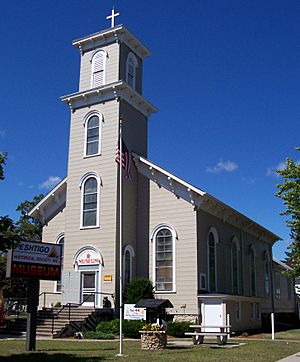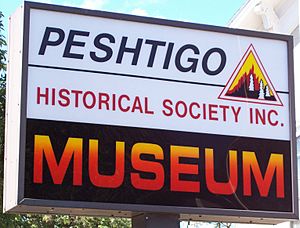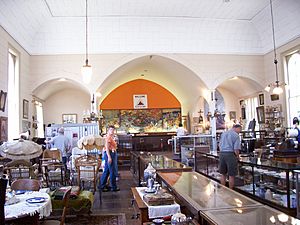Peshtigo Fire Museum facts for kids
The Peshtigo Fire Museum helps us remember the terrible Peshtigo Fire. This huge fire destroyed the city of Peshtigo, Wisconsin on October 8, 1871. It also burned the areas around it. More than 2,000 people lost their lives in this disaster. The museum shows items from the fire and how people lived back then. It also tells stories about the event. Right next to the museum is the Peshtigo Fire Cemetery. Here, the remains of over 350 people are buried together. This cemetery is a special historical place. It has the first official state historical marker in Wisconsin.
Contents
What You Can See at the Museum
The museum has many interesting items from the Peshtigo Fire. One special item is a Church tabernacle. A local priest, Father Peter Pernin, saved it. He put it into the Peshtigo River to protect it. The tabernacle came out of the fire without any damage.
Amazing Items from the Fire
Other items from the fire include a small, burned Bible. There is also a melted glass dish. A construction worker found this dish in 1995. The Bible is open to Psalms 106 and 107. You can also read letters from people who lived through the fire. These letters describe what it was like. One letter talks about burying hundreds of people.
Maps and Murals
The museum also has maps of Peshtigo. One map shows the city before the fire. Another map shows how far the fire spread. A large mural shows scenes from before, during, and after the fire. This helps visitors understand the event.
Life in the Past
Besides fire items, the museum displays old items from the area. These items show what life was like long ago. All the items in the museum were given as gifts.
History of the Museum Building
The museum stands where St. Mary's Catholic Church once was. This church burned down in the Peshtigo Fire. The first church rebuilt after the fire was a Congregational church. It was across the river from the old St. Mary's site. A new Catholic church was later built at the St. Mary's site.
Changes to the Church Building
The Catholic church burned again in 1927. It was then rebuilt in a different spot. The Congregational church was moved across the river. This happened after 1927. Edmund B. Dupuis moved it to the St. Mary's site. This building was then changed into the museum in 1963.
More to Explore
- Fire museum





